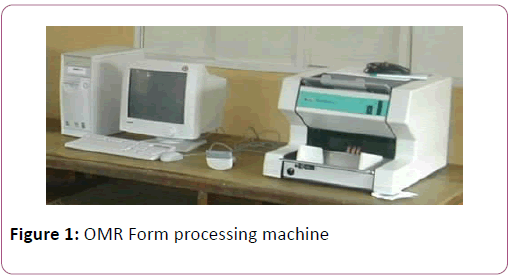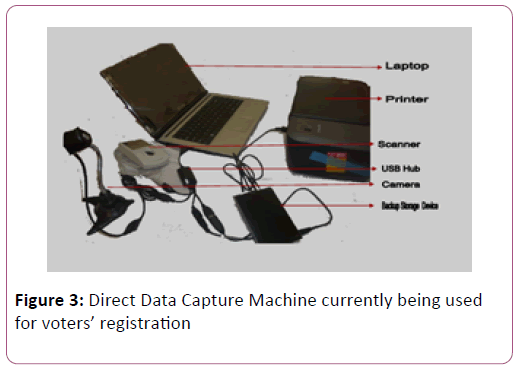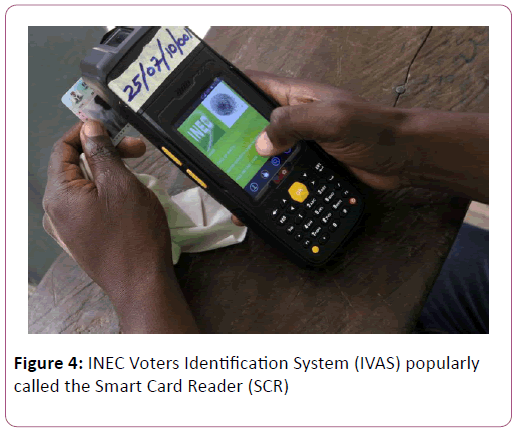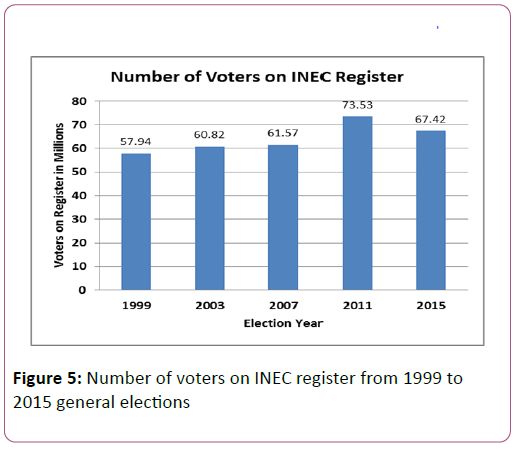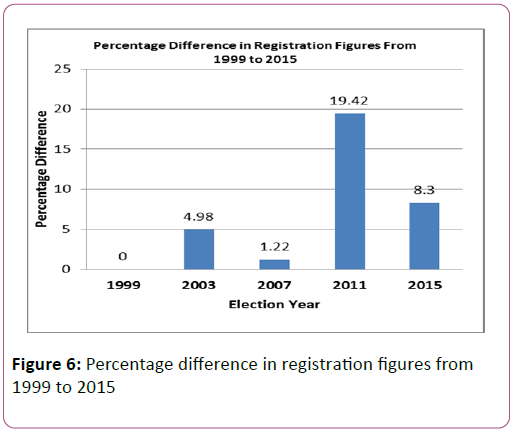ISSN : 2349-3917
American Journal of Computer Science and Information Technology
The Impact of ICT in the Conduct of Elections in Nigeria
Toba Paul Ayeni1* and Adebimpe Omolayo Esan2
1Department of ICT/Voters’ Registry, Independent National Electoral Commission, Ado-Ekiti, Nigeria
2Department of Computer Engineering, Federal University of Oye-Ekiti, Nigeria
- *Corresponding Author:
- Toba Paul Ayeni
Department of ICT/Voters’ Registry, Independent National Electoral Commission, Ado-Ekiti, Nigeria
Tel no: +234- 7030492262
E-mail: tobyeni@yahoo.com
Received date: January 17, 2018; Accepted date: February 06, 2018; Published date: February 09, 2018
Citation: Ayeni TP, Esan AO (2018) The Impact of ICT in the Conduct of Elections in Nigeria. Am J Compt Sci Inform Technol 6:1. doi: 10.21767/2349-3917.100014
Copyright: © 2018 Ayeni TP, et al. This is an open-access article distributed under the terms of the Creative Commons Attribution License, which permits unrestricted use, distribution, and reproduction in any medium, provided the original author and source are credited.
Abstract
There is no gainsaying that technology has drastically reduced incidences of electoral malpractices such as: ballot stuffing, result sheet mutilation, manipulations, over voting, alteration of result sheets and hijacking of ballot boxes in the history of Nigeria elections. The Independent National Electoral Commission (INEC) has employed a number of innovative approaches to improve the management and conduct of elections in the country. As years pass by, INEC gets more sophisticated with its technologies in order to meet up with international standard. Therefore, this paper examines the impact of these technologies and the effect they have on election activities in Nigeria from 1999 general election to 2017. Results show that the introduction of these technologies: Electronic Voters Register(EVR), Automatic Fingerprints Identification System (AFIS) and Smart Card Reader (SCR) have reduced the incidence of multiple registration and multiple voting to the barest minimum while the development of e-collation support platform has drastically reduced incidence of result manipulation at collation centres. Hence, it is believed that the incorporation of Information and Communication Technology (ICT) in Nigeria electoral process has reduced excessive electoral fraud to the barest minimum and foster credible elections.
Keywords
ICT; INEC; Technology; Election; E-collation; Voting; Card reader
Introduction
Democratic societies are founded on the principles of elections and on opinion expression capabilities as observable in most political transitions. Most sovereign nationalities are governed by pure democratic ideals where citizens express their right through the conduct of an election in choosing a leader whom they believe their nation’s destiny can be entrusted with [1]. However, election management bodies around the world have employed a number of innovative approaches, some of which are now considered best practice to improve the management and conduct of elections. Electoral reforms that have been instituted include the use of information and communication technology, adoption of more transparent and inclusive processes, professionalization of the organization, amendments to legal framework and improvement of relationships with external stakeholders. As a result of these efforts, the past several years have seen the varying successes of a number of election management bodies in recent times have recorded a great deal of success in the manner by which they prepare, organize, administer and conduct elections [2].
The importance of Information and Communication Technology in human societies can never be relegated. According to Kroeker and Yonck, the uses of information and communication technologies in recent times have become inevitable and fundamental to operations and activities of organizations and societies. Statistics Canada, opines that information and communication technology is a field of work and study that includes technologies such as the desktop and laptop computers, software, peripherals, and connections to internet primarily for information processing and communications functions. This conceptualization points to the fact that ICT involves the use of computer software and hardware to process information for both private and public use [3]. Research reveals that the usage of ICT in election has eliminated the incidents of multiple registrations, which had been one of the main political tools for rigging elections by unscrupulous and savage elements [4].
Although, it was reported that Nigeria is yet to meet up with international standard for the provision of viable, successful and generally accepted electoral system of democracy due to lack of full implementation of the required electronic voting system in the county that entails combining electronic voters register and smart card readers with election result devices that would be self-auditing and fully equipped with real time facilities [5]. It is believed that the full implementation of the required electronic voting system in Nigeria would improve election management in the country thereby meeting up with international standard.
Materials and Methods
The methods of data gathering for this study were through observation and oral interview. This was carried out with staff of Information Communication Technology and Voters Registry department staff of Independent National Electoral Commission. Some live processes were also observed by the researcher on the field during elections with the aim to identifying all the technologies used by INEC from inception to 2017. Respondents in the oral interview were randomly selected through randomly stratified random sampling techniques and since the result is a descriptive research the gathered information was studied and analyzed. All the information gotten from oral interview, soft copy and hard copy documents were analyzed in tabular form out of which discussions and recommendations were made.
INEC technologies from 1999 to 2017
The methods used in registration of voters and conducting elections in Nigeria from 1999 to 2017 ranges from the use of typewriters to Direct Data Capture Machine (DDCM), Electronic Voters’ Register (EVR), Smart Card Reader (SCR) and e-collation. The steps taken by Gen. Abdulsalami Abubakar after the death of Gen. Sani Abacha in June 1998 paved the way for the historic 1999 general election in Nigeria. Registration of voters was done manually. Registrant details were written with pen on a form provided by INEC. The filled forms were collected and eventually used for the 1999 general election. There was neither any database of voters nor any technology introduced to minimize double registrations; thus the 1999 election registers’ credibility was questionable and was very far from reality. The foundation of any election process is a credible Voters Register. The Voters Register is the basis for determining who is eligible to vote and who is not on Election Day. While the Manual Register of Voters used in the 1988 and 1999 elections served its purpose, it has become outdated with the passage of time [6].
The 2003 election witnessed a technological leap with the introduction of Optical Magnetic Recognition (OMR) forms (Figure 1). While still retaining the manual approach as back up, INEC incorporated computerization, using the Optical Mark Recognition (OMR) technology. This involves the compilation on the form EC.1A of the names and particulars of all prospective voters (also known as Prospective Registrants) who present themselves physically for registration at the Registration Centers. The information so obtained is then transferred and shaded on computer readable OMR Forms, which were later, scanned into database on completion of field operation, and processed to produce the Register of Voters. Each OMR Form has a unique number, which is assigned to the registered voter who is then issued with a new Temporary Voters Card (TVC) bearing the same number and his/her particulars including his/her thumbprint [6].
The OMR registration continued for 10 days while the consortium of Nigerian, South African and European partners were commissioned by INEC to undertake the work. Automated Finger Prints Identification System (AFIS) was then used to clean the register of double registrations. The database of voters was also created. The advantages of OMR technology over the previous one are as follow: it was faster to create; it was more accurate than previous manual method; register can be updated on continual basis; special features were added for security such as the thumbprints. The limitations of OMR technology include the following: absence of photograph of voters; absence of robust database of voters and inability to develop an electronic register. No technology was used for accreditation of voters, voting, sorting and counting, collation and transmission of results.
Meanwhile, the build-up to the 2007 general election marked the beginning of a new era in the history of Nigeria electoral system. The procurement of the Direct Data Capture Machines (DDCM) for the registration of prospective voters introduced some level of credibility to the system (Figure 2). DDCM was introduced to eliminate double registration, double voting and other electoral malpractices. The DDCM components include: a computer system for capturing and storing voters’ information, scanner for taking fingerprints of registrants; camera for taking pictures; back up batteries to forestall power failure, External Hard Disk Drive(HDD) for data backup and printer for printing Temporary Voters Card (TVC). It was recorded that 13,000 integrated data capture systems were deployed by INEC for the 2006 voters registration exercise, 22,000 Direct Data Capturing (DDC) machines, and 18,000 devices for revalidation of voters register for electorates thereby giving enough room for the registration of over 61 million voters with 40,000 DDCs on the whole (with data and the printer units accessories) at the end of the exercise. Research revealed that the adoption of DDC technology with manual back-up for the revalidation of voters’ register made the exercise more transparent, speedy and less cumbersome [4]. Registration of voters was conducted for 81 days due to limited supply of DDCMs to the states. Also, it is believed that the development of an electronic voters register was a giant stride in eliminating double registration and double voting in the history of Nigeria electoral system. Very Small Aperture Terminal (V-SAT) was installed in all the 774 INEC local government offices and state headquarter offices to enable the smooth transmission of election results from various local government areas. Although, these gadgets were not used effectively due to lack of proper training and the issues of nontransparency that trailed 2007 general election. No technology was used for accreditation of voters, voting, sorting, counting and collation of results.
Moreover, the conduct of the 2011 general elections was domestically and internationally acclaimed to be credible and a great leap forward from the previous experiences since the 4th Republic [2]. The search light of INEC under the leadership of Prof. Atahiru Jega in 2010 was focused on the registration of voters as it then existed, which was discovered to have fallen far short of the level of credibility required for the conduct of free and fair elections. The new Commission took the view that an entirely new register of voters was the irreducible minimum for free, fair and credible elections [2] INEC was able to procure and deploy over 132,000 direct data capture machines (DDCMs)-one per 119,973 polling units (PUs) and each of the 8,809 registration areas (RAs), with a provision for some contingencies. The registration exercise was conducted for 21 days (Figure 3). A more effective AFIS was applied to rid the register of multiple registrants while an EVR was generated which was used for the 2011 general election. No technology was used for collation of results. Electronic mail was used to transmit results from local government and state offices to national headquarter in Abuja.
Lastly, 2015 general election marked a new era in the deployment of sophisticated Information Communication technologies in the history of Nigeria elections in addition to existing technologies. Improved Automated Fingerprints Identification System (AFIS) was introduced to identify similar fingerprints on the register used for 2011 election. Business rule was also applied in addition to further clean the register. The business rule required that at least two fingers must be captured for a voter to be included in the register. For the first time, INEC adopted technology for accreditation of voters with the aid of INEC Voters Identification System (IVAS) popularly called the Smart Card Reader (SCR) (Figure 4). Temporary Voters’ Cards (TVCs) which were issued to voters for 2011 election were replaced with the Permanent Voter Cards (PVCs). The PVC replaced the Temporary Voter Card (TVC) According to INEC, quality, security; durability and cost effectiveness were underlying factors in the production of the Permanent Voter Cards by INEC. These cards have many components and specialized features (e.g. base substrate, security printing, personalization, lamination and chip embedding), and it was designed with an average life span of ten (10) years [7]. With the SCRs, accreditation process was broken down into three: Identification, Verification and Authentication. Identificationphysical comparison of the face of the card holder with the image displayed on the SCR when the PVC is read; Verification (that the card is original)- being able to read the information on the chip of the PVC presented; Authentication-comparison of the fingerprint stored on the card with what was physically presented and scanned by the reader. Once PVC has been read and accredited by the SCR, the Voter Identification Number (VIN) is stored in the reader and it does not allow the accreditation of that VIN on that particular reader any longer [8].
A summary of the technology used from 1999 to 2017 are shown in the Table 1 below.
| S/N | Year | Voter Registration | Days For Registration | Data Captured | D-Base | Accreditation/ Voting | Result Collation |
|---|---|---|---|---|---|---|---|
| 1 | 1999 | Pen/Sheets and Typewritters | 14 Days | Basic details. no picture or finger prints | NIL | NIL | NIL |
| 2 | 2003 | Optical Magnetic Recognition Form (Omr Form) *Automated Finger Prints Identification System (Afis) |
10 Days | Basic details and finger prints only | YES | NIL | NIL |
| 3 | 2007 | *Direct Data Capture Machine (Ddcm) * (Afis) |
4 Months | Basic details, photograph, and finger prints | YES | Electronic Voters’ Register (EVR) | Excel Sheet/E-mail |
| 4 | 2011 | *Direct Data Capture Machine (Ddcm) * Afis |
21 Days | Basic details, photograph, and finger prints | YES | Electronic Voters’ Register (EVR) | Excel Sheet/E-mail |
| 5 | 2015 | *Direct Data Capture Machine (Ddcm) *Improved Afis/Business Rule. |
Continuous Voters Registration (CVR) | Basic details, photograph, and finger prints | YES | * EVR *INEC Voters Authentication System (IVAS)/Smart Card Reader (SCR) |
Election Transparency Administration And Collation (e-TRAC) |
| 6 | 2016 | * Ddcm *Improved Afis *Business Rule. |
Continuous Voters Registration (CVR) | Basic details, photograph, and finger prints | YES | *EVR *IVAS |
*Electronic-Collation Support (E-Collation) * e-TRAC |
Table 1: List of various technologies deployed by INEC from 1999 to 2016 for registration of voters, accreditation, voting, collation and transmission of results. (Source: Independent National Electoral Commission)
Result sheets (EC8A) from all the polling units were scanned and uploaded on the Election Transparency Administration and Collation (e-TRAC) platform to further strengthen the transparency of the process. An e-collation website was developed by INEC for collation and transmission of polling units’ results; although it was not used for the general election due to technical problems. E-collation was eventually used in the Kogi State governorship election in 2015 as support to the manual collation. INEC ICT staffs were deployed to collate and transmit results electronically while it’s been collated on paper by the collation officers. All the elections that were conducted in 2016 which include: Rivers State parliamentary rerun, Kogi State gubernatorial rerun, Edo State, Bayelsa State and Ondo State gubernatorial elections, Rivers State parliamentary rerun as well as Osun State senatorial bye election conducted in 2017 witnessed the use of E-collation as support to the manual collation. It gives credibility to result collation by transmitting results in real time process.
Discussion
It is observed from table 1 above that as years pass by, INEC gets more sophisticated with its technologies. For the registration of voters, it started in 1999 with the capture of only basic details of voters. In 2003, it added finger prints which were done on paper forms. It went fully electronic in 2006 with the introduction of biometrics-(pictures and fingerprints) which gave birth to the popular Electronic Voters Register (EVR). In 2011, INEC introduced AFIS to detect and to minimize cases of multiple registrations. In 2015, an improved AFIS was further used to clean the register. Business rule was also applied in 2015 which allowed for the capture of minimum of two fingers as the criteria for inclusion of any voter in the electronic register. It is believed that with the use of a licensed AFIS, INEC would be able to eradicate or reduce to the barest minimum cases of multiple registrations.
A great technological improvement is also observed in result collation and transmission. Though INEC has not fully implemented the use of technologies for collation due to lack of legal framework, the introduction of e-collation support platform has further added credence to INEC transparency. Manual and electronic collations are done simultaneously. The electronic platform automatically sums up votes which serve as check and balance for the manual collation. Results were transmitted in real time which has drastically reduced incidence of manipulations at collation centres.
The total number of voters on INEC register for general elections from 1999 to 2015 is shown in figure 5 above. It can be deduced from the chat that INEC through the regular use of its technologies by its staff is now more technologically efficient. This is evident in the number of days voters registration was conducted in 2006 compared to 2011. It took INEC 4 months to register 61,567,036 voters in 2006 while it registered 73,528,040 within 21 days in 2011. The number of voters registered in 2011 differs with that of 2007 by 19.42% which represents over 12 million voters. This is due to the INEC improvement on the quality of machines and personnel used for the 2011 voters’ registration.
In figure 6 above, a shortfall of 6,106,035 voters is observed on the register between year 2011 and 2015 which represents 8.30% of the total voters in the EVR despite the further addition of 2015 continuous voters’ registration (CVR) exercise figures. The reason is the re-introduction of an improved AFIS in 2015 which led to the deletion of over five million double registrations from the EVR. The introduction of business rule which only allows voters who has at least two fingerprints captured in the register further reduced the number of voters on the register drastically. With the rate of technological advancement of INEC, it is believed that issue of multiple registrations will be completely eradicated or reduced to the barest minimum in the future elections.
Conclusion
The incorporation of ICT in Nigerian electoral system has really modernized the system and improved election management in the country. Results revealed that the introduction of Electronic Voters Register (EVR), Automatic Fingerprints Identification System (AFIS) and Smart Card Reader (SCR) have reduced the incidence of multiple registration and multiple voting to the barest minimum while the introduction of e-collation support platform has drastically reduced incidence of manipulations at collation centre’s because results are transmitted in real time. Hence, the incorporation of Information communication Technology in election management in Nigeria has curbed excessive electoral fraud to the barest minimum, foster credible elections and added credence to INEC transparency.
Recommendation
It is believed that INEC would overcome the challenge of delay in the final collation of results if the use of electronic collation is fully implemented with all necessary legal frameworks. It will save collation officers the risk of travelling in the dead of the night to get results submitted for final collation. It would also save INEC some costs.
The current electronic register needs to be updated due to the fact that some of the voters on the register are dead; many permanent voters’ cards are yet to be collected while issues of multiple registrations have not been fully resolved. Trying to clean the register further may be very expensive and may not eventually yield the desired results. The weak business rule adopted which requires at least two fingerprints for inclusion in the register needs to be reviewed. Also, the high number of card readers’ authentication failures calls for serious concern. In the light of all these issues raised, the call for outright abandonment of the current voters’ register is imperative. It is recommended that the current register be discarded while a fresh voter’s registration is conducted with more sophisticated electronic machines that would easily capture potential voter’s fingerprints in a jiffy just as the ones used for the recent banks verification numbers (BVN) exercise. A licensed AFIS should be procured to rid the new registers of any occurrences of multiple registrations.
In addition, Collection of voters’ cards should be tracked online to ensure the cards get to the owners and to allow INEC to keep proper record of those who have collected their cards up to date. Voters who refuse to collect their cards before any major election should not be included in the register for such election. Since no one is allowed to vote without a permanent voter card; anyone whose card is with INEC some weeks to any general election is definitely not ready to vote and should be removed from the register to minimize cases of inconclusive elections. This will ensure that only voters who are willing, ready and qualified to vote is only included in the register.
Register update and voters’ revalidation exercise should be done before any general election. This will enable INEC to detect and remove dead voters from the register. In addition, enough time should be allocated to ICT-based activities e.g.: computer purging and installation for Continuous Voters Registration (CVR); Smart Card Reader purging and configuration; and printing of registers. Eleventh hour rush will always give room for avoidable mistakes which might generate unnecessary tension and problems. It will also reduce the stress of technical support staff.
Furthermore, ICT staff of INEC should be made to undergo certification courses and training both in Nigeria and oversea. This will reduce the cost of outsourcing ICT-related tasks to consultants. It will also minimize security risk. It is also recommended that the operating system on card readers should be upgraded or another set of devices should be procured which will be able to detect and authenticate fingerprints easily.
References
- Ahmed AM, Usman M (2015) The Impact of Technology on Nigeria’s Democratic Development: An Analysis Of The Card Reading Machine. Int J Multidisciplinary Res Modern Edu 1: 2.
- Jega AM (2012) Report on the 2011 General Elections. Independent National Electoral Commission.
- Kroeker KL (2010) Engineering the web`s third decade. Association for Computing Machinery 53: 16-18.
- Ejikemejombo N (2015) Information and Communication Technology and Administration of 2015 General Election in Nigeria. Mediterranean J Social Sci MCSER 7.
- Esan AO, Ayeni TB (2017) E-voting in Nigeria: Barriers to full implementation. Ahmadu Bello University.
- The Carter Center National Democratic Institute for International Affairs (1999) Special report series-Observing the 1998-99 Nigeria Elections.
- Agbu O (2016) Unbridled Election Rigging and the Use of Technology: The Smart Card Reader as the ‘Joker’ in Nigeria’s 2015 Presidential Election. Research and Studies Department, Nigerian Institute of International Affairs.
- Nwafor C (2016) Technology Gaps, Communication & New Direction for Elections in Nigeria; Paper presented At the Situation Room’s Stakeholders’ Forum.

Open Access Journals
- Aquaculture & Veterinary Science
- Chemistry & Chemical Sciences
- Clinical Sciences
- Engineering
- General Science
- Genetics & Molecular Biology
- Health Care & Nursing
- Immunology & Microbiology
- Materials Science
- Mathematics & Physics
- Medical Sciences
- Neurology & Psychiatry
- Oncology & Cancer Science
- Pharmaceutical Sciences
